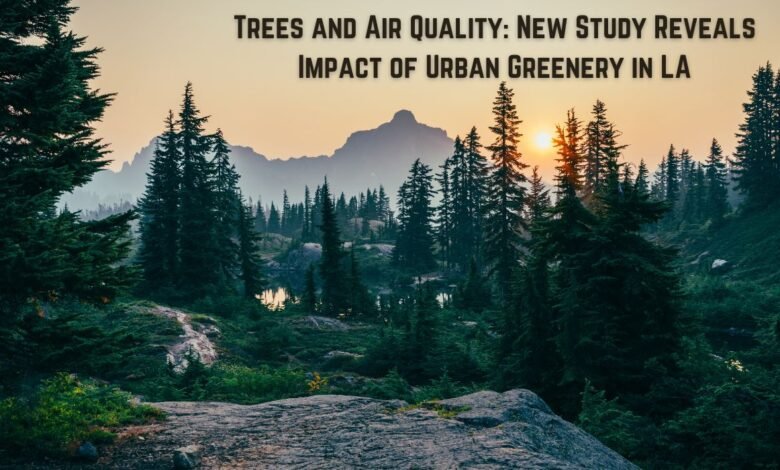Trees and Air Quality: New Study Reveals Impact of Urban Greenery in LA
Discover how urban greenery in LA affects air quality. A new study reveals the significant impact of trees on the city's environment.

In recent years, the topic of air quality in urban environments has garnered significant attention. As cities expand, the concentration of pollutants in the air becomes a pressing concern, impacting public health and overall quality of life. Urban areas, characterized by dense populations and heavy vehicular traffic, often face challenges related to smog, particulate matter, and other airborne contaminants. These pollutants can exacerbate respiratory conditions, contribute to cardiovascular diseases, and reduce life expectancy.
Urban greenery, which includes trees, shrubs, and other vegetation within city landscapes, has been identified as a potential solution to mitigate these air quality issues. Trees, in particular, play a crucial role in absorbing carbon dioxide, releasing oxygen, and filtering harmful pollutants from the air. The presence of green spaces in urban settings can also reduce the urban heat island effect, thereby lowering temperatures and improving overall environmental conditions.
A recent study has turned its focus to Los Angeles (LA), a city known for its sprawling urban landscape and significant air quality challenges. By examining the impact of urban trees in LA, the study aims to provide insights into the effectiveness of urban greenery as a tool for improving air quality. This research is critical as it offers data-driven evidence on the benefits of urban trees, which can guide future urban planning and environmental policies.
The Importance of Trees in Urban Areas
Trees play a crucial role in urban settings by providing a multitude of benefits that enhance the quality of life for city dwellers. One of the primary advantages of urban trees is their ability to act as natural air filters.
Through the processes of photosynthesis, trees absorb carbon dioxide and various pollutants, such as nitrogen dioxide, sulfur dioxide, and particulate matter, from the atmosphere. In return, they release oxygen, which is essential for human and animal life. This natural purification process significantly improves air quality, making urban environments healthier for residents.
Additionally, trees contribute to temperature regulation within cities. Urban areas are often subject to the “heat island effect,” where concrete and asphalt absorb and retain heat, causing higher temperatures compared to surrounding rural areas. Trees provide shade and release water vapor through a process called transpiration, which cools the air. This cooling effect can reduce the need for air conditioning, leading to lower energy consumption and decreased greenhouse gas emissions.
Moreover, the presence of trees in urban areas has been linked to numerous mental health benefits. Green spaces and tree-lined streets provide a sense of tranquility and connection to nature, which can reduce stress, anxiety, and depression. Studies have shown that exposure to green environments can improve mood, cognitive function, and overall well-being.
Here are some key benefits of trees in urban areas:
- Air purification: Absorbing pollutants and releasing oxygen.
- Temperature regulation: Providing shade and cooling the air through transpiration.
- Mental health benefits: Reducing stress and enhancing overall well-being.
- Energy savings: Lowering the demand for air conditioning.
- Noise reduction: Acting as natural sound barriers.
- Increased property values: Enhancing the aesthetic appeal of neighborhoods.
Inclusion of trees in urban landscapes is not merely an aesthetic choice but a vital component of creating healthier, more livable cities. These natural assets offer a range of benefits that are indispensable for both environmental sustainability and human well-being.
Overview of the New Study
The recent study on urban greenery in Los Angeles was conducted by a team of environmental scientists from the University of California, Los Angeles (UCLA). The primary objective of the study was to understand the impact of urban greenery on air quality in densely populated urban areas. The researchers aimed to quantify the benefits of urban greenery in mitigating air pollution, particularly focusing on particulate matter (PM) and nitrogen dioxide (NO2) levels.
To achieve these objectives, the study employed a multi-faceted methodology. The researchers utilized satellite imagery to map out green spaces across Los Angeles, including parks, street trees, and private gardens. They also installed air quality monitoring stations at various strategic locations throughout the city to measure real-time levels of pollutants. These stations collected data over a span of 12 months, ensuring seasonal variations were accounted for.
In addition to quantitative data, the study incorporated qualitative assessments through community surveys. Residents were asked about their perceptions of air quality and the presence of urban greenery in their neighborhoods. This participatory approach allowed for a more comprehensive understanding of how urban greenery is perceived and its potential psychological benefits.
The findings revealed a significant correlation between areas with dense urban greenery and lower levels of air pollutants. Notably, neighborhoods with higher tree coverage exhibited reduced concentrations of PM and NO2, suggesting that urban greenery plays a crucial role in improving air quality. The study also highlighted the importance of equitable distribution of green spaces, as communities in lower-income areas often had less access to greenery and, consequently, poorer air quality.
This groundbreaking study provides valuable insights into the role of urban greenery in enhancing air quality and underscores the need for urban planning policies that prioritize the expansion and maintenance of green spaces in cities like Los Angeles.
Key Findings of the Study
The recent study on the impact of urban greenery in Los Angeles has unveiled several noteworthy insights into how green spaces contribute to air quality improvement. The key findings of the study can be summarized as follows:
- Urban greenery significantly reduces air pollutants, including particulate matter (PM2.5) and nitrogen dioxide (NO2), by up to 25% in densely vegetated areas.
- Tree canopy coverage was found to have a direct correlation with lower levels of air pollution, particularly in neighborhoods with minimal industrial activity.
- Green spaces provide a cooling effect that mitigates the urban heat island phenomenon, further contributing to air quality by reducing the ozone formation rate.
- Areas with higher concentrations of trees reported a noticeable decrease in respiratory issues among residents, highlighting the health benefits of urban greenery.
- Surprisingly, the study found that certain types of trees, such as oaks and pines, are more effective at filtering pollutants compared to other species.
- Economically disadvantaged neighborhoods, which often have less access to green spaces, showed higher levels of air pollutants, underscoring the need for more equitable distribution of urban greenery.
One of the most significant results was the discovery that even small increases in tree canopy coverage can lead to measurable improvements in air quality. This finding emphasizes the critical role that urban greenery plays in enhancing environmental health and overall quality of life for city residents. The study’s data strongly supports the implementation and expansion of green infrastructure projects as a viable solution to combat air pollution in urban settings.
How Trees Improve Air Quality
The integration of urban greenery in cities like Los Angeles has a significant impact on air quality, which directly translates into numerous health benefits for the population. Trees and plants play a crucial role in filtering pollutants and releasing oxygen, thereby improving the overall environment. The reduction in pollution levels often leads to a noticeable decline in various health issues.
Improved air quality due to urban greenery can lead to the following health benefits:
- Fewer Respiratory Issues: Cleaner air reduces the prevalence of asthma, bronchitis, and other chronic respiratory conditions.
- Reduction in Allergies: Trees and plants can help in trapping airborne allergens, leading to fewer allergy symptoms and flare-ups.
- Decreased Cardiovascular Problems: Reduced exposure to pollutants can lower the risk of heart attacks, strokes, and other cardiovascular diseases.
- Enhanced Mental Health: Improved air quality is associated with lower stress levels, better sleep, and enhanced overall mental well-being.
- Lower Cancer Risk: Decreased levels of carcinogenic pollutants can contribute to a lower risk of certain types of cancer.
- Improved Immune Function: Cleaner air can enhance the immune system’s ability to fight off infections and diseases.
- Better Child Development: Children are particularly vulnerable to poor air quality. Cleaner air can lead to better lung development and overall health in children.
Incorporating urban greenery not only beautifies city landscapes but also brings about substantial improvements in public health. The correlation between trees and air quality highlights the importance of maintaining and expanding green spaces in urban areas to foster healthier communities.
Case Studies from Other Cities
Urban greenery has been an essential component in enhancing air quality in numerous cities worldwide. New York City serves as a prominent example through its MillionTreesNYC initiative, launched in 2007. The program aimed to plant one million trees over the course of a decade. By 2015, the goal was achieved, resulting in improved air quality and reduced urban heat islands. Studies showed a significant drop in air pollutants such as sulfur dioxide and particulate matter, demonstrating the direct impact of urban forestry on public health and environmental sustainability.
Similarly, Singapore has earned the moniker “City in a Garden” due to its extensive green infrastructure. The city-state’s commitment to urban greenery is evident through initiatives like the Park Connector Network, which integrates parks and natural reserves into the urban landscape. According to research, these efforts have led to a measurable reduction in urban temperatures and a marked improvement in air quality, benefiting both residents and the broader ecosystem.
Melbourne, Australia, offers another compelling case. The city launched its Urban Forest Strategy in 2012 with the goal of increasing tree canopy cover to 40% by 2040. Early reports indicate that the program has not only enhanced air quality but also improved mental well-being among residents. The presence of green spaces has been correlated with lower levels of stress and anxiety, further underscoring the multifaceted benefits of urban forestry.
Comparatively, Los Angeles has made strides with its own urban greenery initiatives, but faces unique challenges including higher levels of vehicular emissions and a sprawling urban layout. While efforts such as the Million Trees LA program have planted hundreds of thousands of trees, the city still contends with air quality issues. However, insights from other cities’ successful programs offer valuable lessons. For instance, adopting a more integrated approach like New York’s or focusing on comprehensive green infrastructure as seen in Singapore could amplify LA’s efforts in improving air quality through urban forestry.
Challenges and Limitations
Increasing urban greenery presents several challenges and limitations, especially in densely populated cities like Los Angeles. One of the primary obstacles is space constraints. Urban environments are often characterized by limited available land due to existing infrastructure and high land prices. Finding suitable areas for planting trees and creating green spaces can be difficult, as it often involves negotiating with property owners, repurposing vacant lots, or even rethinking urban planning strategies.
Funding is another significant challenge. Establishing and maintaining urban green spaces require substantial financial investment. This includes costs associated with purchasing land, planting trees, and ongoing maintenance. Budget constraints within city governments can limit the ability to allocate sufficient resources for these projects. Additionally, securing private investment or public-private partnerships can be a complex and time-consuming process.
Maintenance of urban greenery is an ongoing concern. Trees and green spaces in urban areas demand regular care to thrive, including watering, pruning, pest control, and soil management. The maintenance workforce needs to be adequately trained and equipped, and the costs for these activities need to be factored into long-term planning. Without proper upkeep, the health and benefits of urban greenery can diminish over time.
The study focused on the impact of greenery in Los Angeles also highlighted several limitations. One notable limitation is the uneven distribution of green spaces across different neighborhoods. Areas with higher socioeconomic status tend to have more greenery compared to lower-income areas. This disparity can affect the overall air quality benefits that urban greenery provides, as not all residents experience the same level of improvement.
Furthermore, the study noted that certain types of trees might not be suitable for all urban environments. Some species can cause allergic reactions or require more water than others, which is a critical consideration in a city like Los Angeles that faces water scarcity. The selection of appropriate tree species is essential to maximize benefits while minimizing potential drawbacks.
Future Directions and Recommendations
As Los Angeles faces increasing challenges related to air quality, the recent study highlights the critical role of urban greenery in mitigating pollution levels. Moving forward, several strategies can enhance the city’s green infrastructure. One primary recommendation is the expansion of tree planting initiatives, particularly in densely populated and industrial areas where air quality is most compromised. By increasing the urban canopy, the city can further capitalize on trees’ natural ability to absorb pollutants and produce oxygen.
Another important recommendation from the study is the diversification of tree species. Planting a variety of trees can enhance resilience against diseases and pests, ensuring a sustainable urban forest. Additionally, species selection should consider the specific environmental conditions of different neighborhoods, optimizing the growth and health of urban greenery. The study also suggests integrating green spaces with other urban infrastructure projects, such as green roofs and walls, which can provide additional benefits in terms of air quality and aesthetic value.
Community involvement is crucial to the success of these initiatives. Engaging local residents through educational programs and volunteer tree-planting events can foster a sense of ownership and responsibility towards urban greenery. Such community-based approaches not only strengthen social cohesion but also ensure the maintenance and longevity of green spaces. The study emphasizes that public awareness campaigns about the benefits of trees and how individuals can contribute to their care are essential for sustained community participation.
Policy support is equally vital. The study recommends that city planners and policymakers prioritize green infrastructure in urban development plans. Incentives for private landowners to plant and maintain trees, coupled with stricter regulations on preserving existing green spaces, can significantly contribute to the overall urban canopy. Furthermore, collaboration with environmental organizations and leveraging state and federal funding can provide the necessary resources to implement these recommendations effectively.
In conclusion, enhancing urban greenery in Los Angeles requires a multifaceted approach that combines strategic planning, community engagement, and robust policy support. By following these future directions, the city can improve air quality and create a healthier, more sustainable urban environment for all residents.
- Human footprints in New Mexico really may be surprisingly ancient, new dating shows
- Why this year’s climate conditions helped Hurricane Beryl smash records
- Antikythera Mechanism (2024): New Insights from Gravitational Wave Research
Conclusion
In examining the findings of the recent study on urban greenery in Los Angeles, several crucial points emerge. The research highlights the significant role that trees play in improving air quality within urban settings. By acting as natural air filters, trees trap pollutants such as particulate matter and absorb harmful gases like nitrogen dioxide and carbon monoxide, leading to a tangible decrease in air pollution levels. The study also underscores the additional benefits of urban greenery, including temperature regulation, enhanced biodiversity, and improvements in mental and physical well-being for city inhabitants.
Los Angeles, a city known for its air quality challenges, has demonstrated through this study the immense potential of urban tree planting initiatives. The data clearly shows that neighborhoods with higher tree density experience better air quality, which translates to healthier living conditions for residents. This positive impact of urban greenery is not just limited to air quality improvement but extends to creating more livable and sustainable urban environments.
With the evidence laid out, it becomes imperative for policymakers, community leaders, and residents to support and advocate for urban tree planting initiatives. By doing so, we can collectively contribute to cleaner air, a healthier population, and a more resilient ecosystem. The benefits are multifaceted and long-lasting, making urban greenery an essential component of any city’s strategy for environmental and public health improvement.
We encourage our readers to get involved in local tree planting programs, support policies that promote urban forestry, and raise awareness about the critical role of trees in our cities. Together, we can make a substantial difference in enhancing air quality and fostering a greener, healthier urban landscape for future generations.
FAQ: Trees and Clean Air
How do trees and forests affect air quality and human health in urban areas?
Trees and forests act as nature’s air filters! They:
- Trap air pollutants: Leaves capture dust, smoke, and pollen, reducing their presence in the air we breathe.
- Absorb harmful gases: Trees take in carbon dioxide, a major greenhouse gas, and release oxygen through photosynthesis.
- Cool urban areas: Trees provide shade, lowering temperatures and reducing smog formation.
These benefits contribute to cleaner air, which can improve respiratory health, reduce allergies, and even lower stress levels.
How can vegetation protect us from air pollution?
Vegetation, including trees and other plants, acts as a barrier between us and air pollution. By trapping particles and absorbing gases, they lessen the amount we breathe in.
How do trees contribute to air quality?
Trees are champions of clean air! They act like natural vacuum cleaners, filtering out pollutants and releasing fresh oxygen. They also help regulate temperature, reducing the formation of smog.
What is the role of forests in influencing the quality of air?
Forests play a crucial role in maintaining global air quality. They act as massive carbon sinks, absorbing vast amounts of carbon dioxide, a key driver of climate change. They also release moisture into the atmosphere, helping to regulate rainfall patterns.
What air pollution effects are usually found on trees?
Unfortunately, trees aren’t immune to air pollution themselves. High levels of pollutants can damage leaves, hinder growth, and make them more susceptible to disease.
What trees are best for air quality?
Many trees excel at filtering air pollution. Some good choices include oaks, maples, pines, and elms. Look for trees with large, hairy leaves that tend to trap more particles.
Which tree is best for the environment?
The “best” tree depends on your specific needs and location. Native trees are generally well-adapted to the local climate and require less maintenance. Trees with fast growth rates can absorb more carbon dioxide quickly.
Which tree is suitable for controlling dust pollution?
Trees with small, dense leaves are particularly effective at trapping dust particles. Some good options include holm oak, eastern white pine, and American arborvitae.



